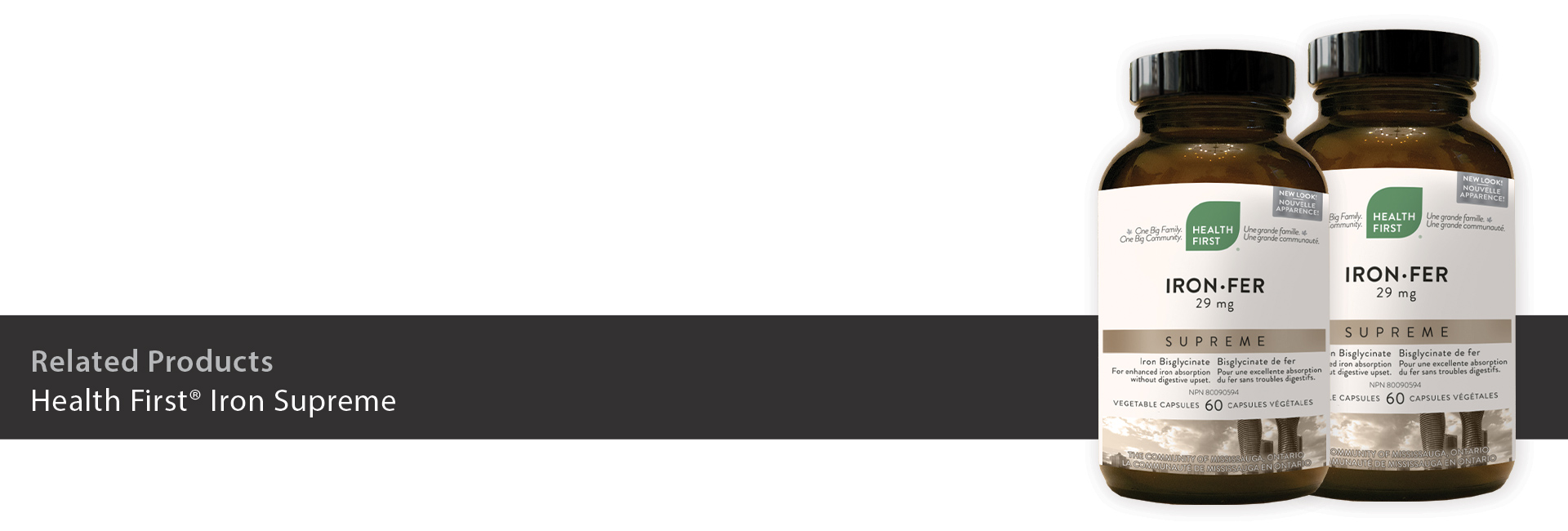

Are you Feeling Weak, Tired and Irritable?
You could be ironed-out.
Iron deficiency and anemia – Could this be the cause of your fatigue and lack of stamina?
The World Health Organization of the United Nations calls iron deficiency anemia the world’s most prevalent nutritional disorder, affecting over 20% of the world’s population.1 Anemia is the result of insufficient red blood cells or hemoglobin in the blood which reduces the amount of oxygen that can be distributed to the body’s organs, resulting in low energy and other symptoms. The most common cause of anemia is iron deficiency.2
While anemia can be diagnosed by measuring red blood cells and hemoglobin, many individuals with an iron deficiency are not yet anemic and suffer undiagnosed (see “Determining an Iron Deficiency”). Iron deficiency is more common in developing countries, but a significant degree is observed in North America in certain populations, such as women of childbearing age. Approximately, twelve percent of women between 20 – 49 years of age are iron deficient with even higher rates for Latino and African-American populations.3 Other groups at risk are First Nations and Indo-Canadian, vegans and endurance runners.8
Premenopausal women are the group most susceptible to being iron deficient. Iron loss in menstruation leaves approximately 25% of premenopausal women with insufficient iron levels. Higher iron usage in pregnancy and lactation also cause iron deficiency. In adult males and postmenopausal women, the cause of iron deficiency can be serious – two-thirds of the time it is due to gastrointestinal bleeding.4
The typical symptoms of iron deficiency are:
- fatigue
- weakness
- reduced stamina
- headaches
- dizziness/fainting
- low blood pressure
- pale lips and eyelids
- loss of libido
- coldness in extremities
- depressed immune system
These symptoms occur because there is insufficient iron to produce hemoglobin to carry oxygen to the major organs – heart, lungs, kidneys – causing them to overwork. The symptoms are even more dramatic in children. Iron deficiency in children can reduce learning capacity and attention span while causing irritability.6
Causes of Iron Deficiency:
- Gastrointestinal bleeding
- Genitourinary bleeding
- Menstruation
- Repeated blood donation
- Growth
- Pregnancy and lactation
- Poor diets
- Intestinal malabsorption
- Internal parasites
- Gastric surgery
Source: Handbook of Nutrition and Food, CRC*
Iron supplementation – What are the options?
One of the ways to deal with the effects of iron deficiency and anemia is through iron supplementation. The most common forms of iron for supplementation are ferrous fumarate, ferrous gluconate, ferrous sulfate, Fe (III) polymaltose, Fe-choline-citrate and ferrous citrate. All of these forms of iron absorb at different rates and side effects. Common side effects from iron supplementation are stomach problems such as constipation, cramps and gastric upset. Certain iron supplements may also interact negatively with other nutritional supplements and drugs. It is important to find a safe, effective iron supplement to reverse iron deficiency.
One option for supplementing iron is Ferrochel®, a patented form of chelated iron (ferrous bisglycinate) that is both easily absorbed by the body and safe for long-term use.
Iron absorption – How to get the iron your body needs without side-effects?
A key to reversing an iron deficiency is finding an iron supplement that is bioavailable and absorbable. Ferrochel®, a patented chelated iron, (ferrous bisglycinate) is a form of iron like heme iron (chelated or protein bound iron), which is not affected by dietary factors that can interfere in iron absorption.
Published studies conducted by well-known researchers throughout the world have consistently shown Ferrochel® to be more bioavailable than other forms of iron (see chart). A study conducted on anemic children found Ferrochel® to have an apparent absorption rate of 70-75%, 3.7 times that of iron from commonly prescribed ferrous sulfate.6*
Ferrochel® in a 30 mg treatment group, restored hemoglobin in the anemic adolescents to the same level as the 120 mg ferrous sulfate group. Most significantly, 32% of the adolescents taking the ferrous sulfate complained of gastric side effects (gastrointestinal upset, constipation and occasionally diarrhea). None of the adolescents taking 30 mg of iron as Ferrochel® had any complaints.7*
Iron Safety Issues – Short-term and long-term
Toxicological studies have been conducted on Ferrochel® iron at the University of Utah. These studies compared the safety of Ferrochel® with ferrous sulfate. Taking into consideration Ferrochel®’s greater absorption, it was considered to be almost 10 times safer than ferrous sulfate.10
Another question to address in iron supplementation is the long-term safety of the supplement used. Ferrochel® was studied in a multi-generational study on pigs. The pigs were fed a diet containing 500 mg of Ferrochel® iron, per day for four consecutive filial generations. The researchers who evaluated these animals could not detect any biochemical, physiological, or histological changes in these animals compared to normal animals. Histochemical analysis found no abnormal accumulation of hemosiderin, which means that there was no evidence of excess iron accumulation in the animals’ tissues. This is evidence that even at this high dose (500 mg/day) Ferrochel® chelated iron is able to be metabolized – strong evidence of low toxicity and safety for long term use.11*
The overall safety found with Ferrochel® may be a function of its unique patented chemistry: a chemistry that permits the body to handle this form of iron with an ease and efficiency not seen with other forms of iron. Ferrochel® is preferentially absorbed in the jejunum with some absorption in the duodenum. Iron salts are primarily absorbed in the duodenum. Ferrochel®’s absorption is not inhibited by dietary components such as phytates, phosphates, other metals, phenols, and tannins that generally reduce absorption of iron salts. Ferrochel®’s movement from the lumen into the mucosal cells is several times more rapid and in greater quantity than that of inorganic iron because it does not enter into the chemical reactions normally associated with iron salts.12*
Iron Testing – Determining an iron deficiency
If you think that you have symptoms of iron deficiency, you should consult your health care practitioner for further testing.
Diagnosis of iron deficiency: Laboratory investigation of iron deficiency should be based on clinical suspicion, not on presence of anemia. In the early stages, iron deficiency can exist without overt anemia, but with non-hematological symptoms.
- Serum ferritin is the best diagnostic test for iron deficiency. A ferritin concentration below 15 µg/L for adults and 12 µg/L for children indicates iron deficiency. These cutoffs include most cases of iron deficiency; however, deficiencies can occur in the low normal range.
- Ferritin measurements may be unreliable in patients with concurrent acute or chronic inflammation, malignancy, hepatic or kidney disease. Patients with persistently elevated serum ferritin levels, without chronic inflammatory disorder should be tested for iron overload.8*
Iron Dosages – Dealing with anemia
How much iron do you need to deal with an iron deficiency? The British Columbia Medical Association recommends 180 mg of elemental iron per day to replenish iron stores. Anemia can be resolved in 2 – 4 months and therapy should continue for 4 to 6 months or until your physician observes serum ferritin (blood iron) levels of 50 µg/L.8
Health First Iron Supreme
Iron Supreme is designed to increase blood iron content efficiently. Iron Supreme helps to form red blood cells, helps in their proper function and helps to prevent iron deficiency.
- Made with patented Ferrochel® iron (ferrous bisglycinate)
- Clinically shown to be more easily absorbed than other iron forms
- Clinically shown to be more well-tolerated than other iron forms
- Non-constipating
- Formulated in a complex of Vitamin C, Folic Acid, Vitamin B12 and other important B vitamins and minerals and vegetable extracts designed to assist iron absorption
- Easy-to-swallow vegetable capsule
- Suitable for vegetarians
References:
1. Albion Research Notes. December 1993. Volume 2, No 6. “Iron Treatment Failure”.
2. http://www.nlm.nih.gov/medlineplus/anemia.html
3. Albion Research Notes. December 1993. Volume 2, No 6. “Iron Treatment Failure”.
4. Albion Research Notes. February 2003. Volume 12, No 1. “The Iron Conundrum”. Table 1.
5. http://www.emedicinehealth.com/anemia/page3_em.htm
6. Albion Research Notes. February 1996. Volume 5, No 1. “Research on Ferrochel”.
7. Albion Research Notes. July 1992. Volume 1, No 1. “Study Shows Ferrochel Superior to Salts”.
8. British Columbia Medical Association. “Investigation and Management of Iron Deficiency.” 2004.
9. Albion Research Notes. February 1996. Volume 5, No 1. “The Trouble With Iron”.
10. Albion Research Notes. February 1996. Volume 5, No 1. “Ferrochel – Higher Margin of Safety Against Overdose.”
11. Albion Research Notes. February 1996. Volume 5, No 1. “Safety In Long Term Usage”.
12. Albion Research Notes. February 1996. Volume 5, No 1. “Safety By Nature”.

